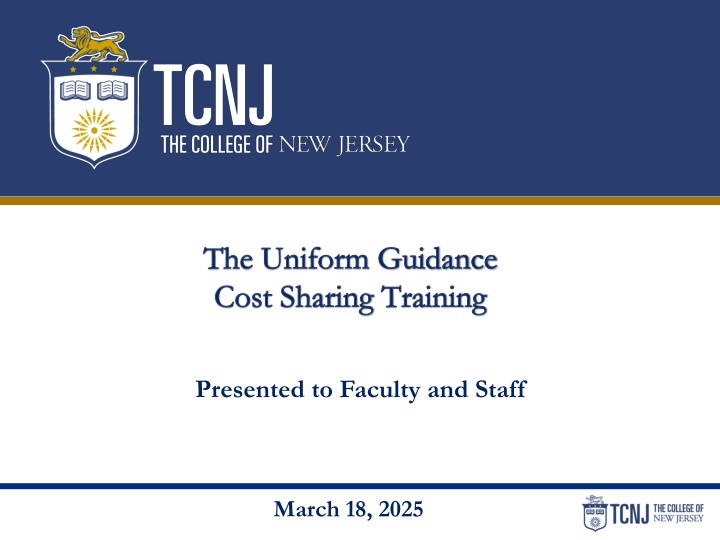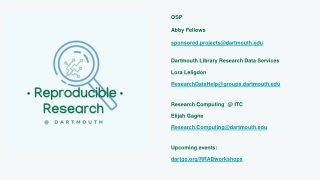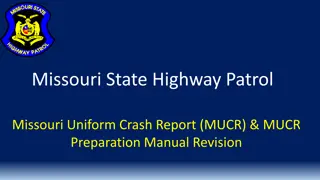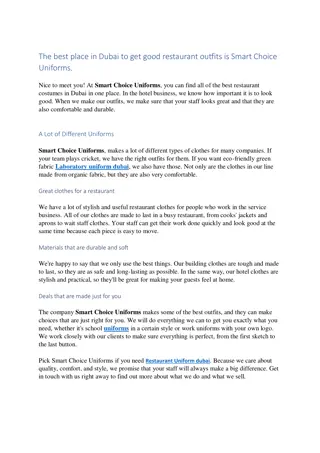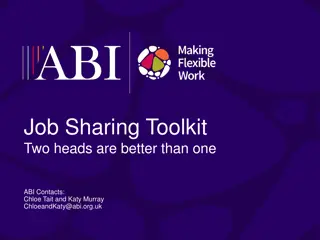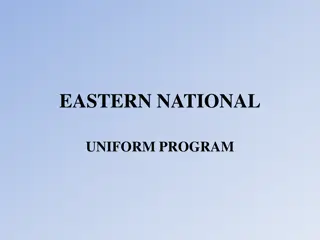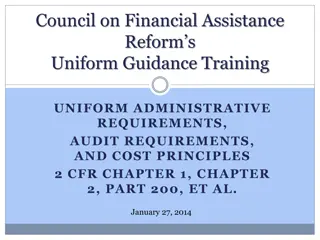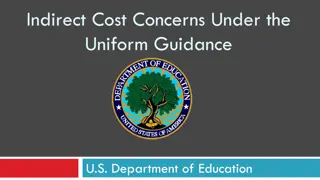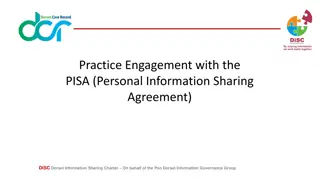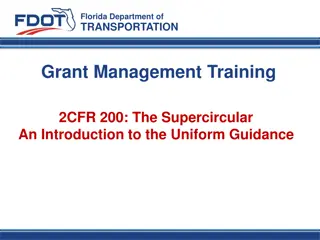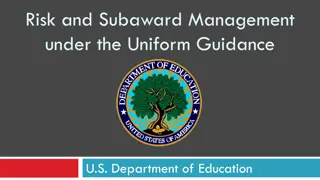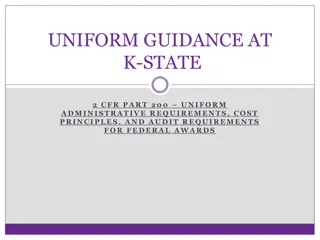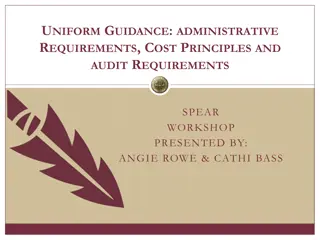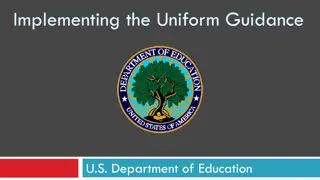Uniform Guidance Cost Sharing Training Overview
The presentation provides an overview of the Uniform Guidance cost sharing training, including background information, changes in regulations, effective dates for existing awards, institutional impacts, and post-award requirements related to cost sharing policies. It highlights key takeaways, roles, responsibilities, and available resources to ensure understanding of the regulations and where to find answers to potential questions.
Uploaded on Mar 18, 2025 | 0 Views
Download Presentation

Please find below an Image/Link to download the presentation.
The content on the website is provided AS IS for your information and personal use only. It may not be sold, licensed, or shared on other websites without obtaining consent from the author.If you encounter any issues during the download, it is possible that the publisher has removed the file from their server.
You are allowed to download the files provided on this website for personal or commercial use, subject to the condition that they are used lawfully. All files are the property of their respective owners.
The content on the website is provided AS IS for your information and personal use only. It may not be sold, licensed, or shared on other websites without obtaining consent from the author.
E N D
Presentation Transcript
The Uniform Guidance Cost Sharing Training Presented to Faculty and Staff March 18, 2025 0
Agenda and Outcomes Agenda Introductions Background on the Uniform Guidance Cost Sharing Processes Roles and Responsibilities Key Takeaways Resources Outcome: After this training we expect that you should have an understanding of the Uniform Guidance and the changes to the regulations for cost sharing (also know as matching); you should know your responsibilities, and know where to find answers to any questions that may arise. 1
1. Background on The Uniform Guidance 2
Background on Uniform Guidance OVERVIEW OF CHANGES The Uniform Guidance includes a combination of: Current Language from Existing Circulars Revised Language of Existing Circulars New Language The final guidance which went into effect December 26, 2014 superseded requirements from: OMB Circulars A-21, A-87, A-110, and A-122 (which have been placed in 2 C.F.R. Parts 220, 225, 215, and 230), Circulars A-89, A-102, and A-133 The guidance in Circular A-50 on Single Audit Act follow-up What Changed? What Remained the Same? Combined 8 Circulars into 1 Adjusted and revised the language and added new language Granted greater flexibility to the recipient Placed greater emphasis on institutional policies and internal controls In many respects the guidance remains unchanged However, just the change itself will result in increased scrutiny because of the renewed awareness and focus 3
Overview of Uniform Guidance & Institutional Impact EFFECTIVE DATES EXISTING AWARDS & GUIDANCE Existing Awards Pre-Existing Guidance Once the Uniform Guidance goes into effect for non-Federal entities, it will apply to Federal awards or funding increments after that date. It will not retroactively change the terms and conditions. Entities will likely make changes to their own policies and procedures that will impact their existing/older awards. Non-Federal entities wishing to implement entity-wide system changes to comply with the Uniform Guidance after the effective date of December 26, 2014 will not be penalized for doing so. TCNJ has adopted policies and procedures that impact existing awards. The terms and conditions for Federal awards (i.e. 2 CFR 220, 225, and 230) always govern. The Uniform Guidance is now in effect, Federal agencies need to ensure the continued availability of access to the terms and conditions of Federal awards made prior to the Uniform Guidance becoming effective. 4
Overview of Uniform Guidance & Institutional Impact POST-AWARD REQUIREMENTS - COST SHARING Establishes positive cost sharing policy, which limits when cost sharing can be required as well as eliminates voluntary cost share as a factor during the review of an application. FINAL OMB UNIFORM GUIDANCE Cost sharing can only be required when clearly defined in the funding opportunity notice. INSTITUTIONAL IMPACTAND IMPLICATIONS Federally required institutional cost share will be limited. Voluntary committed cost sharing should not be used as a factor in the review of applications. Institutions will have additional regulations-based support to discourage voluntary cost share commitments. Voluntary committed cost sharing is prohibited for Federal project proposals except where otherwise required by statute. 5
2. Cost Sharing 6
Administrative Requirements COST SHARING Definition: The portion of project costs not borne by the sponsor. These costs are either born by the organization or potentially a third party. Can be direct costs or indirect costs (with agency approval) Must be necessary and reasonable Must meet criteria for allowable project costs, as outlined in the award notice, and must adhere to the Uniform Guidance cost principles (see Allowable Costs training at http://academicgrants.tcnj.edu/ug-training/) Not reimbursed by the sponsor and, therefore, must be supported by internal or external funds Total Project Costs Sponsor Paid Costs Shared Costs Third Party Cost Share Recipient Org. Cost Share 7
Cost Sharing COST SHARE TYPES Voluntary Committed Cost Sharing Not formally required by sponsor but proposed by the organization in addition to any awarded funds Uncommitted Cost Sharing Mandatory Cost Sharing Required by sponsor as a condition of receiving the award Represents additional effort or costs expended on the project that was not required by the sponsor Quantified in the proposal stage of the award Actual effort was more than the required cost share amount on the award or purchase cost more than budgeted cost share Cost sharing that is documented and quantified in the proposal This form of cost share may also be listed in the Award Notice These additional costs must be funded by the cost share source or another approved source Both mandatory and voluntary committed cost sharing must be internally tracked and documented. TCNJ does not allow voluntary cost sharing. 8
Cost Sharing COST SHARE TYPES Matching Requirement A type of cost sharing, where the organization will match the financial value of the sponsor s grant to help fund that specific project Costs that are borne by an external organization (i.e. individuals at another organization volunteer their time to support the project, or when another organization provides a grant to be used as cost share for a sponsored project Third party must state in writing that their contribution is cost share Third-Party Contribution 9
Cost Sharing REQUIREMENTS Organizational costs can be used to meet cost sharing requirements when they are: Verifiable to internal records (i.e. TCNJ chartfields and supporting documents) Not included as contributions for any other sponsored project Are necessary and reasonable for accomplishment of project or program objectives Allowable under cost principles, e.g. consistent treatment, allowability, allocability, reasonableness Are not paid by the Federal government under another sponsored project Provided for in the approved budget when required by awarding agency Conform to other provisions of the Uniform Guidance 10
Cost Sharing REQUIREMENTS Sponsored project costs are not allowed to meet cost sharing commitments when they are: Volunteer/uncompensated faculty time Costs in support of organized research Sponsored project or sponsored project pass-through funds Incurred outside project dates Unallowable costs 11
Cost Sharing COST SHARE TRACKING Cost share tracking requires the coordinated efforts of several award management teams and related processes throughout the grant lifecycle. Post-Award Identification Approvals Validation Reporting Management Pre-Award Closeout 12
Cost Sharing REQUIREMENTS Organizations should have the following cost sharing materials in place: An organization-wide cost sharing policy Step-by-step documentation procedures Internal forms & sample documentation Electronic tracking of commitments Training 13
Cost Sharing COST SHARE TRACKING Strong organizational cost sharing controls include aspects from policies, procedures and additional forms of support: Policy Procedures Additional Support Organizational position on cost sharing Guidance on seeking agency approval Role expectations Definitions of terms within organizational setting Required internal approvals Procedures for tracking and monitoring FAQs for application Required documentation and monitoring of third- party cost sharing Description of forms for completion Contact information Criteria for cost sharing Disallowed cost sharing within the organization 14
Cost Sharing UNIFORM GUIDANCE IMPACT Other cost sharing guidance new to Uniform Guidance includes: Depreciation on donated assets is permitted in accordance with 200.436 as long as the donated property is not counted towards cost sharing requirement (i.e. you can use either the donated property or depreciation as cost share). Depreciation on donated assets Clarified that indirect costs on cost sharing or matching may be included as part of cost sharing or matching only with the prior approval of the Federal awarding agency. Indirect costs on cost sharing Limitation on fixed amount awards A fixed amount award cannot be used in programs which require mandatory cost sharing or match. Consistent info in awards Organizations will receive a consistent set of information for each Federal award they receive. Includes Total Approved Cost Sharing or Matching, where applicable. 15
3. Processes 16
Processes COST SHARING Principal Investigator (or other support personnel) identifies requirement for mandatory cost sharing or need to include voluntary cost share in sponsored award proposal. Examples of Cost Sharing requirements identified in a RFP: Award recipients must provide non-Federal matching funds at the rate of one non-Federal dollar. Up to one-half of the non-Federal match funds may be in the form of in-kind contributions but at least 50% of match must be in cash. All Mercer County History Grants require a cash match from the applying organization. GOS (General Operating Support) grants require a full cash match (1:1) from the applicant; no in-kind match is applicable for this award . The cash match can come from any source except for funds from any division/department or other funding entity of the State of New Jersey. 17
Processes COST SHARING Principal Investigator (or other support personnel) enters the amount and source of cost share in eGrants for approval by Office of Academic Grants and Sponsored Research (OAGSR) and the Dean. The source of cost share is entered in the Source of Funding box in eGrants when building the budget. 18
Processes COST SHARING 3. Dean or other institutional official committing funds to cover cost share commitments approves the proposal commitment. 4. OAGSR reviews the cost share budget for accuracy and obtains written documentation of third-party cost share and approval from the Provost for all voluntary cost sharing before submitting proposal for funding. Example of third-party documentation: 19
Processes COST SHARING 5. If proposal is funded by sponsor, the PI, OAGSR and the Office of the Treasurer review the cost sharing requirements in the contract. Example: 20
Processes COST SHARING 6. The Office of the Treasurer sets up the cost share companion project budget to track cost share expenses accurately, and the Office of the Treasurer transfers funds from the identified funding source to the cost share companion budget. 7. Principal Investigator (or other support personnel) conducts grant work and charges cost share expenses to appropriate cost share budget and verifies cost shared salary during regular effort verification process (see Compensation and Effort Verification training at http://academicgrants.tcnj.edu/ug-training/). 8. The Office of the Treasurer, with the assistance of the Principal Investigator and project administrative support staff, reports cost share as required by the sponsor. Example report with cost share: 21
4. Roles and Responsibilities 22
Roles and Responsibilities PRINCIPAL INVESTIGATOR IS RESPONSIBLE FOR: 1. Identifying cost sharing commitments, securing the appropriate institutional approvals for proposed cost sharing commitments, and making sure the cost sharing commitments are fulfilled during the course of the project. 2. Ensuring all charges for cost share are properly accounted for in the established companion budget. 3. Considering the administrative requirements and responsibilities inherent in the proposed cost sharing commitment and weigh the cost effectiveness and the expected benefits of the cost sharing. 4. Providing written certification of in-kind matching support on a sponsored project. 5. Directly charging cost sharing expenses to the companion project to ease in the reconciliation and reporting process. 23
Roles and Responsibilities PROJECT ADMINISTRATIVE SUPPORT STAFF ARE RESPONSIBLE FOR: 1. Assisting Principal Investigator with identifying cost share commitments. 2. Assisting Principal Investigator completing the approval forms to secure the institutional approvals required to include cost sharing in proposals. 3. Assisting the PI in management of cost sharing by directly charging the companion project to ease in the reconciliation and reporting process. 24
Roles and Responsibilities DEAN/LEADERSHIP COMMITTING COST SHARE ARE RESPONSIBLE FOR: 1. Reviewing eGrants cost sharing proposals and approving funding for all institutional cost share commitments. PROVOST/DEAN IS RESPONSIBLE FOR: 1. Reviewing and approving all voluntary cost share commitments. 2. Considering the significance of the cost share support to the overall mission of the institution and department when approving mandatory institutional cost share. OFFICE OF ACADEMIC GRANTS AND SPONSORED RESEARCH (OAGSR) IS RESPONSIBLE FOR: 1. Consulting with the Office of the Treasurer on appropriateness and allowability of cost sharing commitments prior to proposal submission. 25
Roles and Responsibilities OFFICE OF THE TREASURER IS RESPONSIBLE FOR: 1. Establishing the cost share budget to track all cost shared expenses in the institutional financial system. The cost share budget shall have a unique Project ID (using the format Cxxxx, where xxxx corresponds to the sponsor-funded Project ID). 2. Transferring funds from the pre-approved source(s) of funds to the Companion Project. 3. Distributing effort verification forms to the Departments to confirm cost shared labor costs. 4. Reporting cost sharing based upon expenditures reflected in cost share companion budget and supporting documentation provided by the PI and other department administration. 26
5. Key Takeaways 27
Key Takeaways COST SHARING The Uniform Guidance has taken productive steps to reducing the burden of cost sharing. Regardless, it is important that an organization maintains strong controls for managing 1. Cost sharing is the cost of sponsored projects not directly funded by the awarding agency. 2. Cost sharing can be done with direct costs or indirect costs (indirect requires prior approval). 3. It must meet criteria for allowable project costs as outlined in the award notice and Uniform Guidance. 4. Mandatory cost sharing is required by the sponsor. 5. Committed cost sharing is documented and quantified in the proposal. 6. Uncommitted cost sharing is not required by the sponsor. 7. Matching requirements require organizations to match a financial value of the sponsor s. 8. The Uniform Guidance establishes that voluntary committed cost share is not expected and cannot be used in merit review 28
Compliance Focus: Cost Sharing MONITORING COMPLIANCE With this federal guidance, ensure organizational policies minimize voluntary cost share c c Determine and document roles, responsibilities and processes for cost share commitment monitoring and verification - Central versus local responsibility - Eliminate over cost sharing or duplicate cost sharing c c Enhance organizational processes for tracking cost share commitments and cost share charges with technology and tools - Companion accounts - GL-based reports c c 29
6. Resources 30
Resources WHERE TO GET HELP 1. Reference updated policies and procedures on the OAGSR website (http://academicgrants.tcnj.edu/) 2. Sign up for or view trainings (http://academicgrants.tcnj.edu/ug-training/) 3. Review the Uniform Guidance Language (http://www.ecfr.gov/cgi-bin/text- idx?tpl=/ecfrbrowse/Title02/2cfr200_main_02.tpl) 4. Ask your colleagues 5. Contact OAGSR Green Hall, Room 202 P) 609.771.3255 E) grants@tcnj.edu 6. Contact the Office of the Treasurer Green Hall, Room 207 P) 609.771.2186 31
7. Appendix 32
Introduction to the Uniform Guidance ORGANIZATION - SUBPARTS Subpart A Acronyms and Definitions Subpart B General Provisions Subpart C Pre-Federal Award Requirements and Contents of Federal Awards Subpart D Post Federal Award Requirements Subpart E Cost Principles Subpart F Audit Requirements 33
Introduction to the Uniform Guidance ORGANIZATION - APPENDIX TO PART 200 Appendix I Full Text of Notice of Funding Opportunity Appendix II Contract Provisions for Non-Federal Entity Contracts Under Federal Awards Indirect (F&A) Costs Identification and Assignment, and Rate Determination for Institutions of Higher Education (IHEs) Indirect (F&A) Costs Identification and Assignment, and Rate Determination for Nonprofit Organizations Appendix III Appendix IV Appendix V State/Local Government and Indian Tribe-Wide Central Service Cost Allocation (Transfer) Plans Appendix VI Public Assistance Cost Allocation (Transfer) Plans Appendix VII States and Local Government and Indian Tribe Indirect Cost Proposals Appendix VIII Nonprofit Organizations Exempted From Subpart E Cost Principles of Part 200 Appendix IX Hospital Cost Principles Appendix X Data Collection Form (Form SF SAC) Appendix XI Compliance Supplement 34
Overview of Uniform Guidance & Institutional Impact COST PRINCIPLES - DIRECT COSTS Guidelines promote the clarification as well as standardization of the direct cost allowability across institutions. FINAL OMB UNIFORM GUIDANCE Further clarifications made in allocability and allowability of certain direct costs. INSTITUTIONAL IMPACTAND IMPLICATIONS A single common cost principles circular creates common accounting standards for all grant recipients, regardless of institutional type. 35
Overview of Uniform Guidance & Institutional Impact COST PRINCIPLES - ADMINISTRATIVE SUPPORT Institutions can charge directly allocable administrative support as a direct cost. FINAL OMB UNIFORM GUIDANCE In order for clerical costs to be allowable as a direct charge, the Federal awarding agency s prior approval is required. INSTITUTIONAL IMPACTAND IMPLICATIONS Institutions may charge administrative and clerical salaries, as well as other items of cost, directly to a Federal award when it is appropriate, allocable and meets the conditions outlined in the Federal guidance. Additional language was added to allow for this approval after the initial budget approval in order to allow for flexibility in implementation. The burden for justifying direct costs as allocable to an award remains with the institution. 36
Overview of Uniform Guidance & Institutional Impact COST PRINCIPLES - COMPUTING DEVICES This change includes the cost of certain computing devices as allowable direct cost supplies. FINAL OMB UNIFORM GUIDANCE Computing devices are subject to the less burdensome administrative requirements of supplies (as opposed to equipment). INSTITUTIONAL IMPACTAND IMPLICATIONS Computing devices not considered a depreciable asset by an institution s capitalization policy may be charged and treated as supplies. The acquisition cost must be less than the lesser of the capitalization level established by the non- Federal entity for financial statement purposes or $5,000, regardless of the length of its useful life. The burden of obtaining prior approval for such purchases is reduced. However, institutions must follow the same practices for determining and documenting allocability (direct versus indirect use) when charging computing devices to sponsored awards. 37
Overview of Uniform Guidance & Institutional Impact POST-AWARD REQUIREMENTS - SUBCONTRACT MONITORING The prime awardee sets requirements and leads subcontract monitoring. FINAL OMB UNIFORM GUIDANCE Subrecipient monitoring tools currently in the Compliance Supplement are integrated. INSTITUTIONAL IMPACTAND IMPLICATIONS 10% MTDC minimum rate facilitates collaboration with subrecipients. Pass-through entities must honor either a negotiated or minimum 10% of MTDC indirect cost rate for sub-recipients. Prime awardee institutions decide what is necessary for monitoring subrecipients, including the review of financial and programmatic reports, in order to meet their own obligations under Federal awards. Subrecipient monitoring via the review of performance and financial reports is limited to what the pass-through entity has deemed necessary to meet their own requirements under the Federal award. Only when findings pertain to federal funds provided to sub-recipients, must the pass- through entity manage corrective actions. Only when findings pertain to Federal award funds provided to the subrecipient by the pass- through entity does the pass-through entity have to follow up, ensure corrective action, and issue management decisions on weaknesses. 38
Overview of Uniform Guidance & Institutional Impact POST-AWARD REQUIREMENTS SUBCONTRACT / VENDOR CLARIFICATION Provides clarification between subrecipient and vendors and assigns responsibility for determination to mitigate disagreements with sponsor classification. FINAL OMB UNIFORM GUIDANCE The agreement characteristics necessary to determine subrecipients vs. vendors on Federal awards are clarified. INSTITUTIONAL IMPACTAND IMPLICATIONS Clarification should help mitigate agency retrospective disagreement of determination. Responsibility for making this determination is assigned to the pass-through entity. 39
Overview of Uniform Guidance & Institutional Impact COST PRINCIPLES - TIME & EFFORT (T&E) As long as institutions comply with general principles of T&E, they can apply unique practices of maintenance, which will lessen the administrative burden. FINAL OMB UNIFORM GUIDANCE Non-Federal entities are required to maintain high standards for internal controls over salaries and wages but are provided additional flexibility on how to implement processes to meet those standards. INSTITUTIONAL IMPACTAND IMPLICATIONS The general principles of time and effort still apply, but all institution types have the ability to implement independent practices for verifying payroll as long as they follow the Federal guidelines. Reporting requirements are consolidated across entities and specific methodologies for IHEs are eliminated. The complex language and example methods have been eliminated. Different allowable and unallowable compensation activities are defined and include special considerations for different types of non- Federal entities. 40
Overview of Uniform Guidance & Institutional Impact COST PRINCIPLES - PROCUREMENT Institutions will have additional procurement standards such as required competition and equipment screening requirements. FINAL OMB UNIFORM GUIDANCE Procurement method requirements are outlined. INSTITUTIONAL IMPACTAND IMPLICATIONS The cost or price analysis threshold, set in accordance with the simplified acquisition threshold, will streamline institutional procurement processes. The threshold for small purchase procedures is raised to $150,000 to be consistent with the simplified acquisition threshold in the Federal Acquisition Regulation (FAR). However, other actions will require additional administration in procurement areas, such as inter-entity agreements for shared services. Non-Federal entities are required to avoid duplicative purchases and encouraged to enter into agreements for shared goods and services. Institutional P-Card policies, especially for purchases over $3,000 may be in conflict with Federal requirements. All A-110 language on procurement is replaced by A-102 section .36. TCNJ will continue to follow its existing procurement policies which comply with the new Federal requirements. Minor clarification to language requires non- Federal entities to maintain oversight rather than a system that ensures contractor performance. 41
